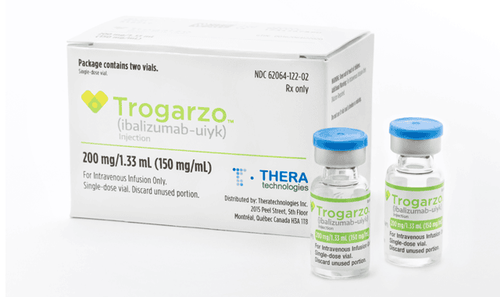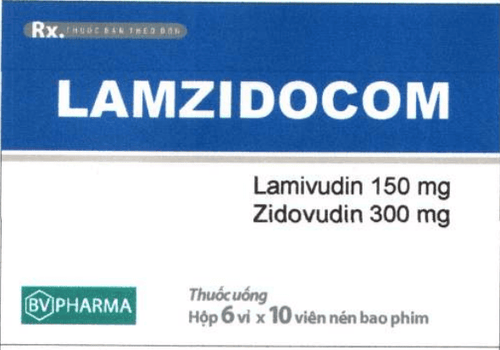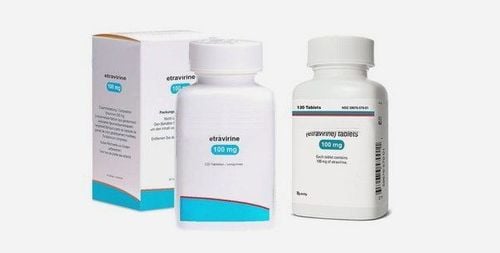This is an automatically translated article.
Mebipharavudin is indicated for the treatment of chronic hepatitis B virus infection in patients with evidence of hepatitis B virus replication and in combination with Zidovudine for the treatment of HIV in adults and children >= 3 months of age. Let's find out the necessary information about the drug Mebipharavudin through the article below.
1. What is the antiviral drug Mebipharavudin?
Active ingredient: Lamivudine (3TC)
Class: Antiviral drug.
Legal group: ETC - (Ethical drugs, prescription drugs, Prescription only medicine)
ATC code (Anatomical Therapeutic Chemical): J05AF05.
Original brand name: Zeffix
Brand name: Antiheb, Bilipa, Mebipharavudin
Manufacturer: Pharmaceutical and medical biology Co., Ltd.
Film-coated tablet: 100 mg.
2. Uses of the drug Mebipharavudin
2.1 Indications Treatment of chronic hepatitis B virus in patients with evidence of hepatitis B virus replication and in combination with Zidovudine for the treatment of HIV in adults and children >= 3 months of age.
2.2 Dosage – How to take it:
This medicine is for prescription only. It is taken by mouth. Dosage:
For people with chronic hepatitis B: 100m/time/day.
For people living with HIV: Lamivudine should always be used in combination with at least one antiretroviral drug, usually in combination with Zidovudine or Stavudine. Lamivudine and the combination are to be taken orally, regardless of meals.
Adults and adolescents 16 years of age and older:
People weighing 50 kg or more: 150 mg of Lamivudine and 300 mg of Zidovudine/time, twice a day. People weighing less than 50kg: 100mg Lamivudine and 200mg Zidovudine/time, twice a day. Adolescents 12 to 16 years old:
People weighing 50 kg or more: 150 mg of Lamivudine and 300 mg of Zidovudine/time, twice a day. People under 50kg: there is not enough data to guide the dose. Children over 3 months old:
Children weighing less than 14 kg: 4 mg/kg body weight/time, twice a day. Up to 300 mg/day. Children weighing from 14 to 21 kg: 75 mg / time, 2 times a day. Children weighing 21 to 30 kg: 75 mg in the morning and 150 mg in the evening. Children weighing over 30kg: 150mg/time, twice a day. For patients with HIV combined with hepatitis B : Apply the dose for patients with HIV.
2.3 Overdose and Management There is little information available on overdose, although in the event of an overdose, no clinical signs or symptoms were observed, otherwise blood tests were normal. There is no antidote. It is not known whether lamivudine is eliminated by peritoneal dialysis or hemodialysis.
3. Note when using the drug Mebipharavudin
Contraindications
Hypersensitivity to Lamivudin or any of its ingredients. Severe kidney disease. Note/Caution
Lamivudine may be associated with lactic acidosis, should be discontinued if there is a rapid increase in aminotransferase levels, patients with progressive hepatomegaly, lactic acidosis or metabolic acidosis of unknown cause. Caution should be exercised in patients with hepatomegaly or those with risk factors for liver disease. In patients with chronic hepatitis B, there is a risk of relapse when lamivudine is discontinued, so liver function should be monitored in these patients. The possibility of HIV infection should be excluded before using lamivudine in the treatment of hepatitis B because low doses for hepatitis can lead to the development of lamivudine-resistant HIV strains. In children with a history of pancreatitis or with risk factors for the development of pancreatitis, when lamivudine and zidovudine are used in combination, close monitoring is required. When there are clinical signs, or abnormal laboratory results suggest pancreatitis, the drug should be stopped immediately. In patients with impaired renal function, children under 12 years of age and adolescents weighing less than 50 kg, do not use a fixed combination product containing lamivudine and zidovudine because it is not possible to adjust each drug separately. Inform patients that lamivudine does not cure HIV infection, they continue to carry the disease, so the patient must still be monitored and cared for continuously. Lamivudine does not reduce the risk of HIV transmission, people with HIV must use condoms to protect their sexual partners. Effects of the drug on the ability to drive and use machines.
Lamivudine does not affect the ability to use machines or drive vehicles.
Use in pregnancy and lactation
Pregnancy: Lamivudine can be used during pregnancy, especially when there is a chance of protection from infection to the fetus. In case of using Lamivudine in combination with oral administration (lamivudine and zidovudine), avoid use in pregnant women.
Lactation: Lamivudine should not be used by women who are breastfeeding because of the potential for undesirable effects due to Lamivudine in nursing infants.
4. Mebipharavudin side effects
Common: Headache, fatigue, malaise, nausea, diarrhea, vomiting, epigastric pain, cramps, insomnia, fever, cough, runny nose, rash and musculoskeletal pain, neuropathy peripheral neuropathy, neutropenia, anemia, increased ALT and AST.
Uncommon: pancreatitis; thrombocytopenia, hyperbilirubinemia; hair loss; angioedema, urticaria, anaphylactic reactions; may exacerbate peripheral neuropathy in patients receiving lamivudine as an alternative to zalcitabine.
Lamivudine must be stopped immediately if clinical signs, symptoms, or laboratory results suggest that pancreatitis may occur
Inform your doctor about unwanted effects when using the drug.
Guidelines for the management of ADR:
Lamivudine should be discontinued immediately if clinical signs, symptoms, or laboratory findings suggest possible pancreatitis.
Lamivudine should be discontinued immediately if clinical signs, symptoms, or laboratory findings suggest lactic acidosis, or hepatotoxicity (hepatomegaly, fat accumulation, even if transaminase elevations are not very high).
5. Drug interactions
The potential for drug interactions is low due to limited metabolism and binding to plasma proteins and almost complete renal elimination as unchanged drug.
Concomitant administration of lamivudine and zidovudine increases serum concentrations of zidovudine (approximately 39%).
Trimethoprim/sulfamethoxazole increases the bioavailability of lamivudine (approximately 44%), and reduces renal clearance (30%).
Food slows the absorption of lamivudine and reduces peak plasma concentrations (approximately 40%) with peak plasma concentrations achieved with fasting dosing.
Please dial HOTLINE for more information or register for an appointment HERE. Download MyVinmec app to make appointments faster and to manage your bookings easily.













